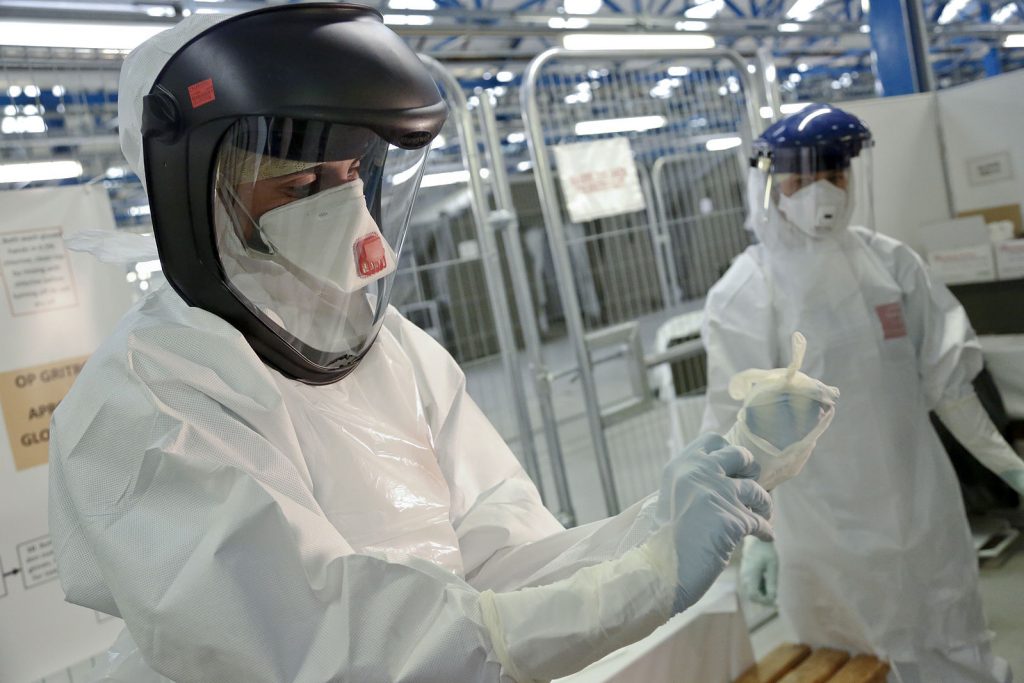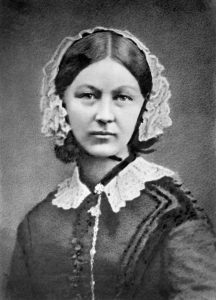Nurse Nina Pham arrived at Texas Presbyterian Hospital in Dallas for her regular shift. The patient that she was assigned to take care of was named Thomas Duncan. Little did she know that this patient would change her life, but not particularly for the better. A few days after Nina met her patient Duncan, she woke up sick. She knew in her heart that she had been contaminated somehow. She was later diagnosed with having the Ebola virus. That day started a long battle for Pham, fighting for her life.

Nina Pham and few other nurses were assigned to take care of Duncan in his most critical state. Nina Pham was his primary nurse, but she was given little information about what disease Duncan was carrying. Nina Pham claims that she lacked the complete training that she needed in order to protect herself. The CDC states that people who care for patients who are suffering from Ebola should have completed comprehensive training on how to protect themselves. According to Dr. Daniel Varga, the chief clinical officer at Texas Presbyterian Hospital, Nina Pham and the other nurses assigned did follow the CDC guidelines for protecting themselves. It is unknown when she came into contact with the disease, but according to Nina Pham, the hospital did not provide everything that it could have to ensure that the nurses were safe. Dr. Varga admitted that the hospital did not have all the resources available at the time and lacked communication, but they still followed the CDC and the state guidelines. By the time Thomas Duncan was moved to the ICU, the nurses began wearing double sets of gloves that were then taped to two gowns. Then they wore two booties and a face shield. Nina Pham claimed that though they were pretty much covered, their necks were still exposed. According to Pham, the nurses were the ones who came up with an arrangement that they felt would better protect themselves. The nurses would use the room next door to place their suits and to clean up after taking care of Duncan. As Duncan got progressively worse, the janitors stopped coming into the room. According to Pham and the three other nurses, they began to work as both janitors and nurses at the same time. They had to clean his bathroom and his room, which made them come into direct contact with his lethal waste. Nina Pham stated that there was so much waste at one point that it could have probably filled half of a patient’s room. It was emotionally and physically draining for the nurses.6 Then, when Duncan died, it left the nurses devastated. It was hard for Nina to lose Duncan, but soon she would be in the same position as him.
Three days later, after Thomas Duncan died, Nina Pham checked herself into the hospital, because she was experiencing a high fever. When she was admitted, she explained who she had taken care of, and what her condition probably was. She was quickly tested for Ebola and indeed tested positive for the disease. The hospital had just recovered from the death of Thomas Duncan, and now it faced another frightening case of Ebola. Nina was immediately placed into isolation. She told an interviewer, “I broke down crying” when she was given the news. All she wanted to do was to do her duty, which now was putting her life at risk. Nina Pham was placed on three experimental drugs. These made her very fatigued, and she claims that she did not remember a lot, due to being in and out of sleep. While she was in treatment, the hospital flew her out to Maryland to be cared for by a very specialized immunologist.7 The doctor was also a scientist and wanted to videotape her recovery in the hospital. This videotape was later released to the public, which became a problem that she dealt with. She knew why the videotaping would be a good thing for science, but she did not want it to be released to the media. Then one day after she was formally diagnosed, the news broke that a doctor named Kent Bently flew into Dallas to donate his blood. This doctor had worked in Liberia and had also contracted Ebola. But he had just beaten the disease, and by donating his blood to her, her blood would then have the antibodies that she would need in order to fight the disease.8 Then, on October 24, 2014, Nina Pham was released from the hospital Ebola-free. This was a victory for the hospital and for her. Though it was a scary time, Nina Pham was able to come out of it whole.

Nina Pham was free of Ebola but she still suffered from the effects of the disease. The doctors told her to be prepared for the long-term effects of Ebola. Some of them are weakening in the sensory nerves, poor vision, and possible failure of organs. She was twenty-six years old at the time when she contracted Ebola. Nina is not sure if she can have children, and whether her children might be affected by the disease. She has also experienced her hair falling out and extreme fatigue. Her liver also produces a high amount of enzymes, which makes it hard for her to eat certain foods.9 As of October 2016, Nina Pham had not returned to work, but was still getting paid regularly. She filed a lawsuit against the hospital, suing for her physical and mental health, medical expenses, and the future loss of earning.10 The specific amount of money that she is suing for is unknown. NBC News reported that it cost up to $30,000 per day to take care of a patient who has Ebola. The prices can increase depending on the severity of the patient. The hospital has to dispose of Ebola patients’ beds, which can cost up to $146,000. Dr. Jeffrey Gold, a school chancellor at the University of Nebraska Medical Center, wanted Congress to create funding and policies that would help to reimburse hospitals that deal with these types of rare diseases.11
Ebola can also affect the economy and the politics of a nation. After the Ebola outbreak, the Obama Administration asked Congress for $6.18 billion to use for emergency funding to help understand rare diseases, and also for how to prevent another outbreak from happening. The money would be parceled to organizations like the CDC, who would receive $1.83 billion. Not only has the United States set up money for a future outbreak and more research, Sierra Leone, Guinea, and Liberia have done the same. Liberia has set aside $812 million dollars, Sierra Leone has put aside $844 million dollars, and Guinea has put aside $2.89 billion.12 Each of these three countries have not only set aside money, but have also created recovery plans. They are all going about the recovery plans in different ways, but they are all aiming for the same thing, which is to update their health care system and work on improvements that will benefit the country. Ebola is not only a hard disease to get rid of, but also an expensive disease. After the Ebola outbreak in 2014, Washington was busy at work trying to figure out ways to reduce the chances of another disease coming into America again. They want to lower the chance of having infected people like Thomas Duncan from bringing Ebola into the United States. The Republican majority in Congress at the time wanted the White House administration to impose a travel ban on West African countries. President Obama did not want to do this because, according to the CDC, a ban would not do much. Instead, the administration wanted to focus on making new safety guidelines to help US healthcare workers deal with diseases like Ebola. Both Democrats and Republicans did settle on making improvements to the hazard suits, training, and education about more diseases for US hospitals.13. Ebola was a real wake up call for America to update their policies and get their priorities straight.Ebola consumes everything in its way. It takes over the victim’s body, the national economy, and a nation’s domestic politics. It is a hard disease to fight and contain. There are many things that scientists need to learn about the disease in order to find more effective cures for it. The 2014 outbreak was like a nightmare that the whole of America woke up to. Thomas Duncan, who lost his life, and Nina Pham, who was close to it, show why it is important for America to rise and take control of its healthcare.
- Nichols Hannah, “Ebola: Symptoms, treatment, and causes,” Medical News Today (May 2017): 1. ↵
- “About Ebola Virus Disease,” Center for Disease Control (February 2016): 1. ↵
- “Ebola virus disease,” World Health Organization (June 2017): 1. ↵
- Richard Preston, The Hot Zone (New York: Random House, 1994), 28. ↵
- Greg Botelho, “Thomas Duncan: First Ebola Death in U.S,” CNN News, (October 2014): 1. ↵
- Jennifer Emily, “Free of Ebola but not fear,” Dallas News (February 2015): 1 ↵
- Frank Heinz, “Pham transported to NIH in Maryland,” NBC-DFW News (October 16, 2014): 1. ↵
- “Dallas nurse battling Ebola says she’s doing well,” ABC News (October 14, 2014). ↵
- Emily Jennifer, “Free of Ebola but not fear,” Dallas News (February 2015): 1. ↵
- Jennifer Emily, “Nurse Nina Pham settles Ebola Lawsuit against Texas Health Resources,” Dallas News (October 2016): 1. ↵
- “Cost to treat Ebola: $1 million for two patients” NBC News (November 2014): 1. ↵
- Zoe Mullan, “The Cost of Ebola,” The Lancet, Vol 3 ( August 2015): 423. ↵
- David Morgan and Toni Clarke, “Republican take aim at US Ebola response after 4th case emerges,” Reuters, (October 24, 2014) 1 ↵



86 comments
Erik Shannon
This was a very good article. It was very well written and the author did a good job at telling us the story more than showing. I remember when Ebola was first discovered and how serious the outbreak became. Doctors and all medical staff and government officials were on alert and standby. Hopefully, we never have to experience something like this happening again. Overall, this was a very good and informative article.
Brianda Gomez
It is crazy to think that a disease can appear from one day to another and frighten millions of people. I remember back learning about Ebola back in 2014 when the outbreak was all over the news. It was frightening to know how a new disease nobody had ever heard about before was killing people in your own state. This was such a well-written article! It is terrifying how one person can kill another by contaminating them with something so scary. It is even worse when you can get it in your own workplace. I really enjoyed reading this article and learning more about the nightmare, Ebola.
Brianda Gomez
I remember back learning about Ebola back in 2014 when the outbreak was all over the news. It was frightening to know how a new disease nobody had ever heard about before was killing people in your own state. This was such a well-written article! It is terrifying how one person can kill another by contaminating them with something so scary. It is even worse when you can get it in your own workplace. I really enjoyed reading this article and learning more about the nightmare, Ebola.
Tyler Sleeter
This is a great article with so much information. It is always interesting to me to read an article about something I remember happening to see if what I think I know matches what really happened. I think this is a case where the medical field learned a lot about an illness in a short period of time. The hospital in Texas was clearly not equipped to deal with the ebola virus but by the time Pham contracted it, they knew what needed to happen to save her life. I am glad that the epidemic eventually ended, for now.
Maria Callejas
This is the second time I read this specific article. Nevertheless, I am still as intrigued as the first time. You use great information and evidence throughout your writing, which definitely adds a sense of legitimacy to it. It really liked how you describe with vivid detail what each victim was going through. As I mentioned in my first comment, I went to Dallas the week after Duncan had passed, so I was worried sick something could happen to me, but luckily nothing happened. Great job!
Luke Willis
This was a very interesting article. I remember when this outbreak occurred and i was always wondering if and when it would hit San Antonio and what would happen. I had seen a documentary on Ebola in high school so i knew just how dangerous the disease was and how fast it could spread as well. It is interesting that because we are in America we were able to contain it better than in Africa but it was still a scary time.
Osman Rodriguez
I remember when this outbreak happened. I was in high school when this event was going on and I know we talked about it in almost every class. The talk spread like the virus itself. I admit, it was a bit scary as it was a very dangerous virus. This should remind us how mother nature is a force to be reckoned with and we can’t take it for granted. Thankfully, an event such as this one has made people more aware of hygiene and to be sanitary.
Gabriela Serrato
I enjoyed this article because while I was so scared during the broadcast of this epidemic, I was unaware of this story. Ebola is frightening, and the entire country was in shock and fear that it was going to spread and devastate the world. I laughed at the ignorance the administration’s idea to ban travel to West African countries. I am ashamed that they thought that would be an actual reasonable solution. But I am glad that President Obama stood up and did not allow that idiocy to take place. This issue is very relevant, especially because it happened so recently and another epidemic could take place in future years. I hope that we, as a country, are better equipped to act in ways to protect everyone. But hopefully nothing of this nature will ever happen again, especially under our current “president” who I am sure would do little to nothing besides put the blame and consequence on other countries.
Cherice Leach
Very interesting article. You have done a great job at researching. There was so much detail and facts that I might have guessed that you had known this nurse. Other than that, you do a great job telling the story of Nina Pham. It’s also very good when you go to a broader scale of Ebola to help your audience understand what the disease is and how it affects people. Very good, my eyes didn’t leave the screen until it was done.
Crystalrose Quintero
I thought the initial image was a strong image to use. I loved that a visual of what gets worn by healthcare when treating ebola was available. I appreciated that the author included a quote from the nurse that was contracted with ebola. To hear a woman say she could not fulfill her duty was such a strong statement that really was needed during such a crisis like this. This article was such an interesting read.